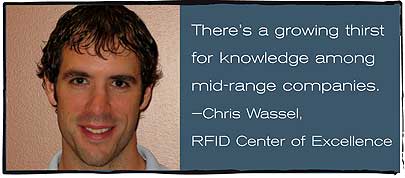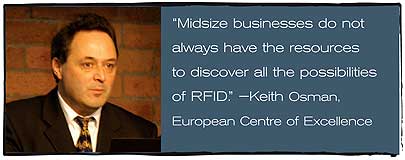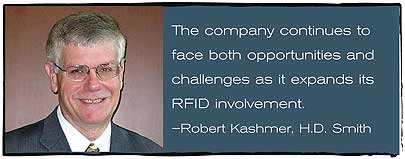Aug 01, 2008Everybody knows about the sweeping RFID initiatives launched by giant enterprises such as Wal-Mart, the U.S. Department of Defense and the Metro Group. Less well-known is the type of RFID system deployed by FirstHealth Moore Regional Hospital in Pinehurst, N.C. The 385-bed community health-care facility, located in a place better known for its golfing than its technological innovation, doesn't need RFID to track and monitor millions of items located at hundreds of sites. Moore Regional's goal is much more basic: The hospital wants to efficiently track and distribute its on-site IV pumps, medicines and other everyday assets. "It's certainly not a global project, but it's important to us," says CIO Dave Dillehunt. "RFID is helping us accomplish a crucial task."
Moore Regional is among a growing number of midsize companies and organizations turning to RFID for the same types of benefits that larger adopters are currently receiving. For the past few years, while giant, global enterprises piloted RFID, overcame challenges, and deployed the technology to streamline an array of internal and supply-chain processes, most midsize companies sat on the sidelines watching—or dismissed RFID as a technology not appropriate for their business. But now, several forces—increasing awareness of RFID's benefits, partner and regulatory mandates, lower tag and infrastructure prices, and standards development—are converging to place RFID on the planning tables of midsize businesses in a wide range of industries.

"We're settling into a pretty healthy growth curve [in midsize businesses]," says Dan Mullen, president of AIM Global, an international trade association for the automatic identification and data capture industry, headquartered in Warrendale, Pa. Mullen points to a May 2008 study from ABI Research showing that RFID is poised to become a $9.7 billion industry within five years as proof that more midsize companies are adopting the technology. "It's not only giant, global companies driving this growth," he says.
But while interest in RFID is growing among midsize businesses, these companies face some unique challenges in adopting the technology, says Chris Wassel, program manager at the RFID Center of Excellence, a venture of Penn State Erie, The Behrend College. "They have smaller R&D and implementation budgets than most larger companies," he says, "and they may not have a large enough workforce to designate someone to learn about and implement the technology."
Still, midsize businesses have some important advantages over mega-corporations. Some, for instance, have yet to even advance to the bar-code stage for tracking assets and shipments. "Such firms are in a perfect position to leapfrog to RFID," Mullen says.
In addition, midsize companies are less likely to be encumbered by bureaucracies, so they can get approval for an RFID project much faster than a very large company—and can even adopt cutting-edge RFID applications. At Moore Regional, an RFID-enabled robotic pharmacy distribution system, developed by Pittsburgh-based Aethon, is giving the hospital the ability to effectively track and distribute medications, devices and assets across its facility. "RFID ensures that the staff not only knows where the equipment is, but can have it brought directly to the point of care, so they don't have to leave the patient care area," Dillehunt says.
At the educational training sessions the RFID Center of Excellence conducts throughout Pennsylvania, Wassel says he's detected a growing thirst for RFID knowledge among mid-range companies. "Some people know what RFID is and leave with a better understanding of how the technology can help their business," he says. "Others have just heard of RFID and are curious to learn more."
Most of the companies Wassel and his team work with, including plastics, steel and lumber manufacturers, are still in the exploratory stage. They're looking to gain more visibility into their operations to reduce costs and improve processes, including tracking inventory and work in process. They also want to see if they can use RFID to provide better service to their customers by helping them solve problems.
RFID testing and trialling is also alive and well on the other side of the Atlantic. "Interest in RFID is certainly growing among the [midsize-business] sector in the U.K.," says Keith Osman, laboratory director of the European Centre of Excellence for Automatic Identification and Data Capture (AIDC), based in Halifax, England. The £5 million ($9.9 million) U.K.-government-funded project aims to help more businesses—particularly small and midsize companies—understand the value of RFID and other automatic identification technologies.
"Several large-scale pilots are under way, particularly in the retail sector," Osman says. "Though the retailers themselves may be large businesses, the other dedicated enterprises in the chain tend to be midsized, working within closed-loop systems."
Tote box and document tracking also are proving to be popular RFID applications among midsize businesses, Osman notes. "There is also increasing use of Wi-Fi active tags for such things as buildings and facilities management—often in tandem with sensors," he says. "In health applications, patients, staff and equipment are being tracked in pilot schemes around hospitals."
Earlier this year, Hershey Entertainment & Resorts, which owns and operates many of the chocolate-themed attractions in the Hershey, Pa., area, began using an RFID keyless control system for the 800-plus guest storage lockers inside Hersheypark. The system, from St. Paul, Minn.-based Smarte Carte, allows guests to rent a wristband that lets them access lockers at three locations inside the park. In addition to providing a convenient service to guests, the reprogrammable wristbands—based on a technology developed by Precision Dynamics, in San Fernando, Calif.—eliminate the need to manage hundreds of easy-to-lose traditional keys associated with individual lockers, and the system helps park employees quickly prepare the storage units for the next day's users.
Although Hershey is just beginning to work with RFID, project director Myles D. Miller says he feels comfortable with the company's current pace of adoption. "We don't want to be on the leading or bleeding edge of things," he says. "We want to be 'first followers'—not necessarily people who are using the technology before everyone, but we also don't want to be the last people to use it."
Mandates from larger business partners and government regulators are often responsible for bringing midsize businesses—particularly suppliers, wholesalers and retailers—into the RFID market. The RFID Research Center at the University of Arkansas, for example, has been working with Sam's Club suppliers to help them understand RFID and compliance issues. Unlike Wal-Mart, which required its top 600 suppliers to begin RFID-tagging goods, Sam's Club is requiring all of its suppliers, including many small and midsize companies, to comply or be charged a service fee.
H.D. Smith, a pharmaceutical distributor in Springfield, Ill., is using RFID to assure the pedigree—or authenticity—of the counterfeit-vulnerable pharmaceuticals it distributes to pharmacies across the United States. The company launched an RFID pilot in 2004, before state and federal pharmaceutical pedigree requirements began coming into effect. The pilot was transformed into a fully operational program about a year later, when Smith's Pompano Beach, Fla., distribution center adopted RFID in advance of the state's deadline for pedigree compliance.
Today, with pedigree laws on the books in Florida and California, and several other states actively considering the issue, Smith has become an old hand at using electronic pedigrees to ensure a pharmaceutical's heritage. Medicines requiring an e-pedigree arriving at a Smith facility are placed in a tote that passes through an RFID portal. If a product hasn't been tagged by its manufacturer, Smith supplies the device. Each item is then interrogated and recorded—the first step in creating the e-pedigree trail. Once it has been created, an e-pedigree is mandatory for every transaction involving that product across the supply chain.
Smith is now beefing up its ability to read various tag formats at its Springfield headquarters distribution site, as well as preparing its California facility to meet that state's new pedigree mandate. In all, the company operates eight DCs nationwide. "We feel very confident that we need to continue our progress so that we are fully prepared for whenever a state decides to regulate us to provide this service," says Robert Kashmer, Smith's VP of information technology.
While many companies face critical mandates, the AIDC Centre's Osman says a growing number of businesses are viewing RFID as a strategic tool that's necessary for tasks extending far beyond working with a single partner. "Most midsize businesses we speak to who have expressed an interest in RFID are conscious of [mandates] long-term, but are mainly concerned about ensuring a continued competitive edge through the best use of AIDC technology," he says.
While midsize businesses are becoming increasingly eager to tap into RFID, many are having difficulty putting their hopes into action. That's because midsize businesses face planning and deployment challenges that most large enterprises can simply shrug off. The biggest barriers are, not surprisingly, financial and personnel resources. "Many medium-size companies are apprehensive to invest in the technology due to the costs," Wassel says.
A big challenge to wider RFID adoption by midsize businesses is a general lack of knowledge, Osman observes. "The hype over RFID has portrayed it as relatively simple in terms of technology and use," he says. Yet this isn't necessarily true. "Midsize businesses do not always have the resources to discover all the possibilities of RFID, all the varieties of technology, and the installation, maintenance and revenue costs," Osman says.
Training is another knowledge-oriented challenge, one that midsize companies need to come to grips with. Training is actually a two-pronged issue, notes Osman, who feels that instruction has to be targeted to both the employee and the job. "Stating the obvious," he says, "the installer needs a different set of skills from those of the operator/user."
Academic research centers are good resources for midsize companies that don't have the staff or funding to dedicate to an RFID project, says Justin Patton, managing director of the RFID Research Center. In addition to working with retail suppliers, the center is working with midsize manufacturers and logistics companies to research appropriate technologies. Academic labs can help companies acquire a solid understanding of RFID, identify the best way to use RFID to solve a business problem, then point them to solution providers that could deploy the system. "They like the lab because it's vendor-neutral," Patton says, "so they feel they're in a trustworthy environment."
The AIDC Centre helps businesses tackle development, training and other critical issues. "We need to engage with SMEs [small and midsize enterprises]—they make up around 70 percent of business enterprise in the U.K.," says Paul Redwin, a senior policy advisor with the U.K. government's Department for Business, Enterprise and Regulatory Reform. "The main problem is getting over the skepticism they have toward the technologies. Centres like this can do the job."
Redwin notes that the AIDC Centre plays an important role in educating midsize U.K. companies on RFID's promise. "Sometimes," he says, "the technologies can appear complex; therefore, you have the job of explaining…through awareness programs and education what the real benefits are." He adds that the AIDC Centre works with companies spanning a variety of industries. "We are looking for a coordinated approach to information across all the sectors and business practices," Redwin says. "This centre will be important in that search."
When the robotics technology came along, Dillehunt realized he could use the system to lower labor costs while providing a more consistent delivery schedule to hospital departments. "Our CEO has final authority on all decisions, of course," Dillehunt says. "But when I was able to show him a proposal with a positive ROI on it, and it solved some of our issues—both inventory tracking and equipment cleanliness—it was an easy sell for me. We put a lot of thought into our project. A little over a year after deployment [the system went live in June 2007], we're confident that we're close to ROI and beyond."
Smith's Kashmer feels that careful planning was crucial to the success of his company's RFID initiative. "We took our time," he says, "and when we set up our projects and our goals, we had a very high degree of confidence that they would be successful."
With smaller budgets at their disposal and a limited amount of influence to throw about, midsize organizations' vendor selection is particularly crucial. Hershey's Miller explains that selecting a vendor requires more than simply scouting around for a company offering the appropriate technology. "Find a vendor you're comfortable with, who can provide the services you're looking for, and who you can see a long-term partnership with," he says. "I didn't want someone to sell me a solution—I wanted someone who was willing to commit to me as much as I was willing to commit to them."
That sentiment is echoed by James Grammas, equipment control manager at warehouse operator Maersk Distribution Services in Madison, N.J. He says the association he built with Santa Clara, Calif.-based RFID vendor WhereNet to build a trailer-tracking yard management system has paid significant dividends in both planning and long-term support. "You partner with your vendor," he says. "It's not like buying shoes, where you walk in, buy them and walk away." Grammas also believes that after forming a partnership, it's vital to commit fully to the project: "There's nothing worse than any kind of hesitation. Focus on your goal and keep driving toward it."
While a sizable number of midsize companies are still confused about RFID's business and operational functions, others that have adopted the technology in highly competitive industries prefer to keep their deployments close to their vest. "They're worried about making RFID pay off in the next six months," Osman says, "so they don't necessarily want to talk about it or need to talk about it with anybody, because if they get value out of it, they don't want to reveal that to their competitors."
Yet other RFID adopters, such as Hershey, Smith and Moore Regional, are happy to discuss their RFID deployments, hoping their experiences will inspire other midsize companies to follow in their path. Dillehunt, for instance, is so satisfied with his work with RFID that he's looking forward to Moore Regional gradually expanding its use of the technology into other key areas, including loss control. "I have no doubt that we'll be seeing more value from RFID in the future," he says. "We're looking at tagging various kinds of loss-prone equipment-like wheelchairs, for example, which disappear much more often than you'd expect. RFID is going to play an important role for us for many years to come."
Also pleased by his initial experience with RFID, Miller is now looking forward to the possibility of applying the technology to other tasks. He says he's examining how RFID can be used down the road in an "all-encompassing" management system for Hershey's local properties. "One thing we're going to tie [RFID] to is a point-of-sale system that will be used everywhere for food, beverage and merchandise," Miller says. "We want to be able to issue passive tags to both the guests who are staying at our properties as well as transient guests."
Miller says he would also like to use RFID to improve park services and security. He envisions, for instance, radio-linked adult/child wristbands that could be used to track the location of children and automatically alert parents to a potential problem—"to have the tag vibrate on the parents' arm, for example, when the child has left the area or the perimeter of what is considered the zone that that device is used in," Miller says. "The system, at the same time, would alert security."
Kashmer believes that the RFID know-how Smith has accumulated over the past few years has enabled the company to gain a substantial head start on its competition. He feels that, with nearly a half-decade of RFID planning, testing and live operation under its belt, Smith is a pioneer not only in the use of RFID in the pharmaceutical industry, but as a midsize-company adopter. "We were in there at the beginning," Krashmer says, "and we're still expanding and refining our use of the technology."
Despite his enthusiasm for RFID, Kashmer is realistic about the role the technology is capable of playing in a midsize business. He admits that Smith continues to face both opportunities and challenges as it expands its RFID involvement. "Opportunity, in that we can move a project much faster than a very large company," he says. "At the same time, we have the challenge that we do not have the revenue stream that a very large company would have."




